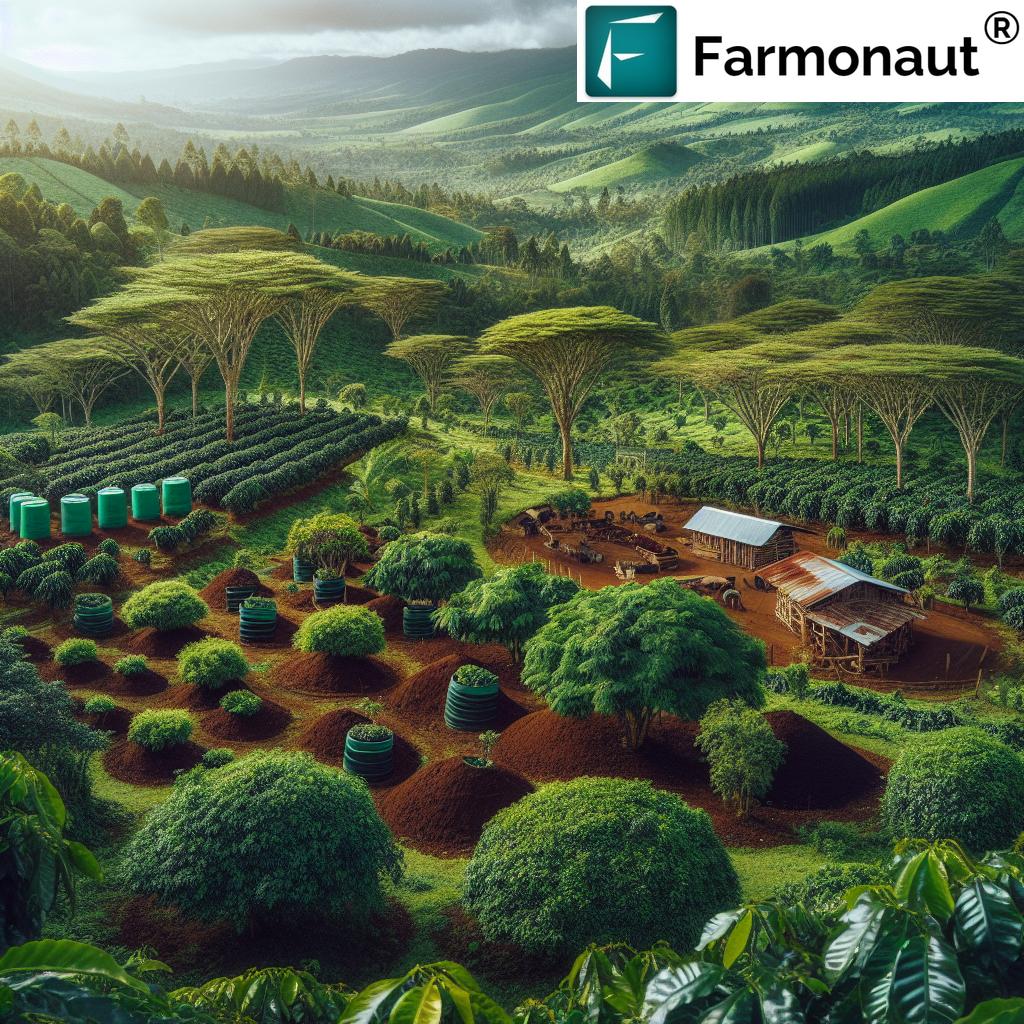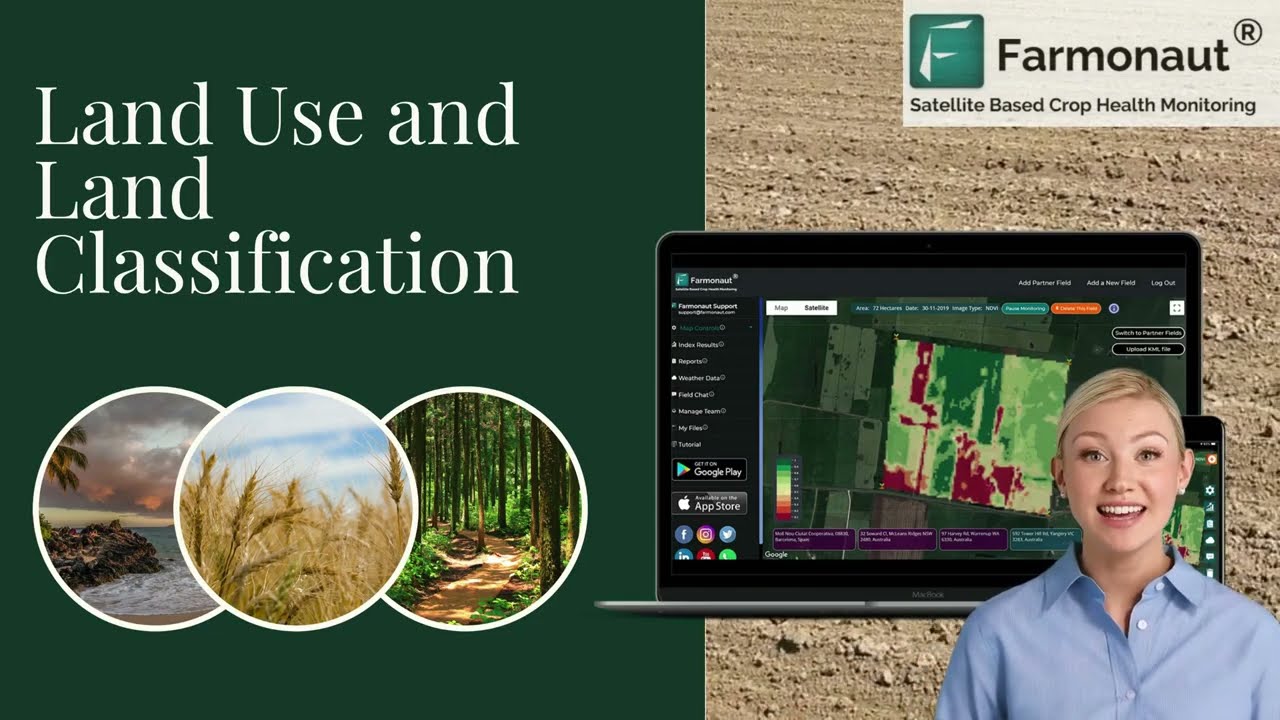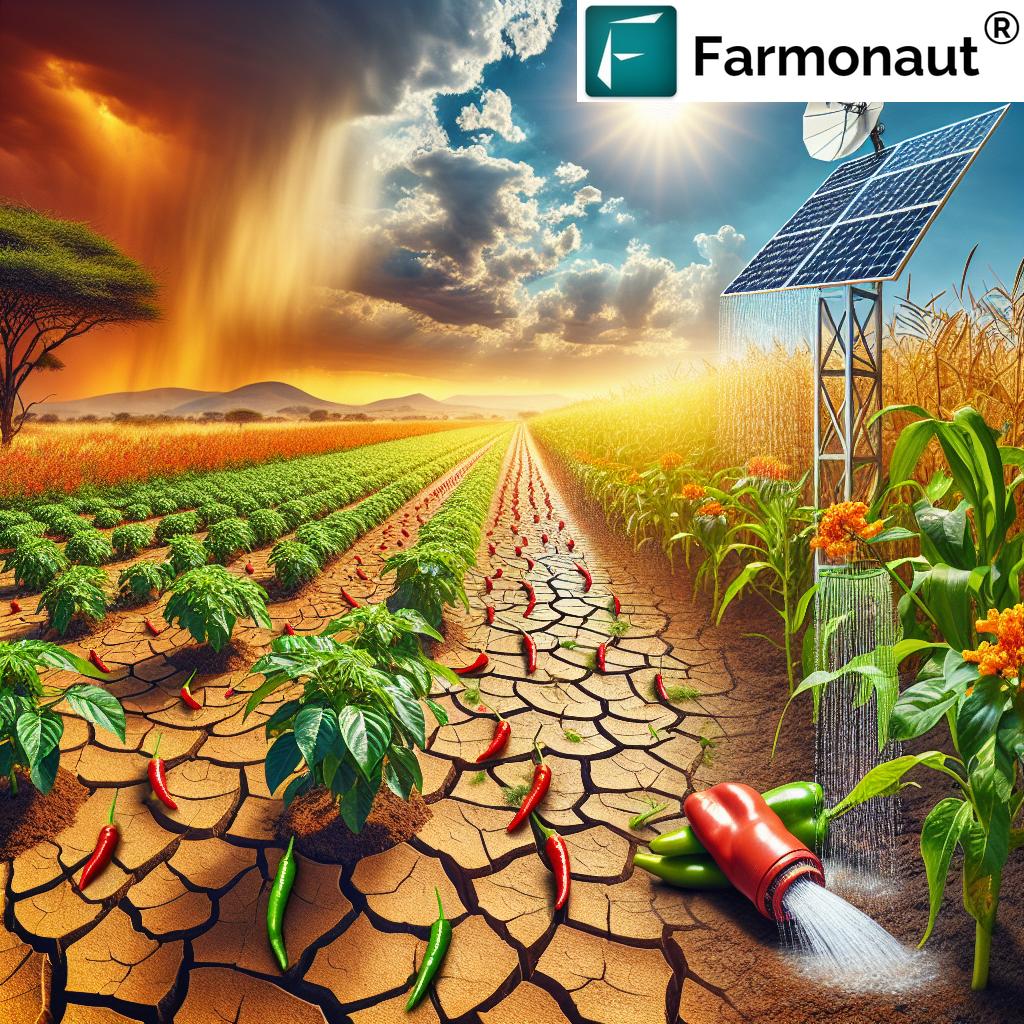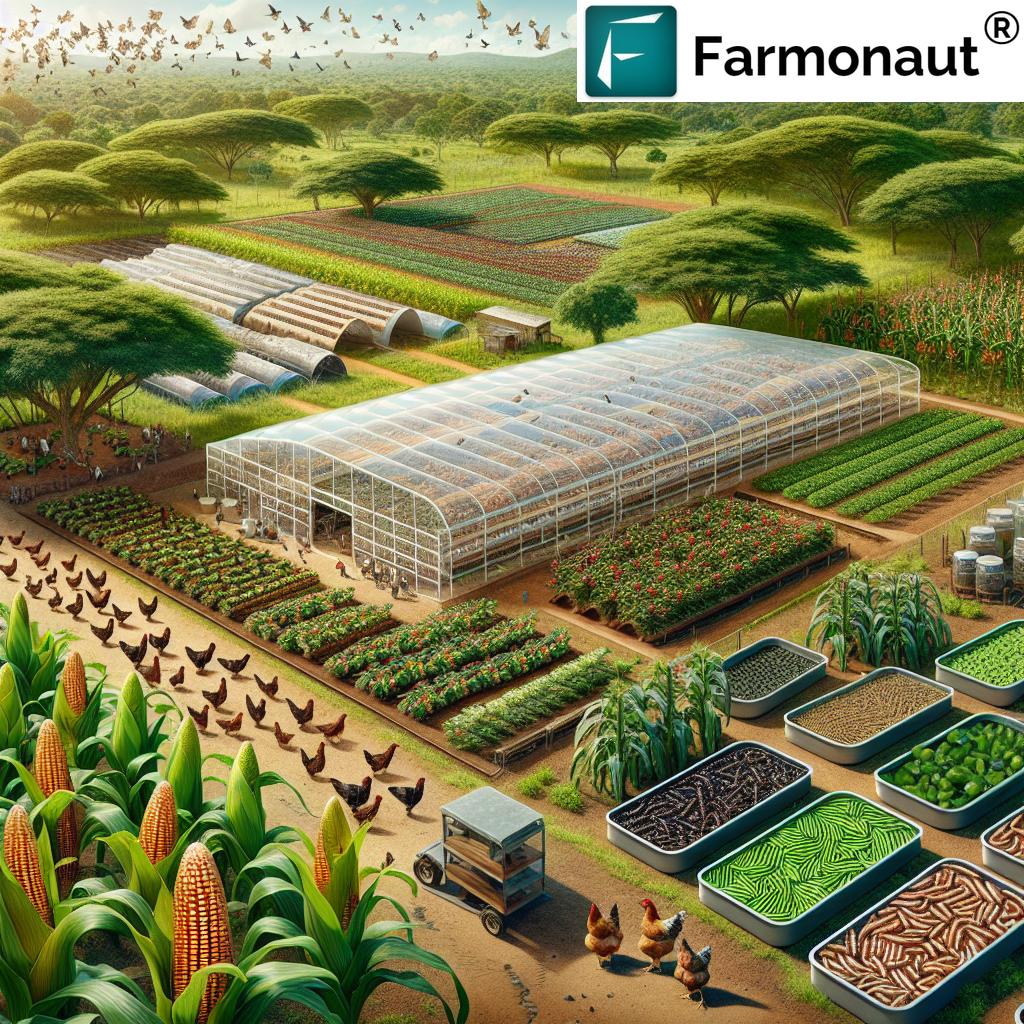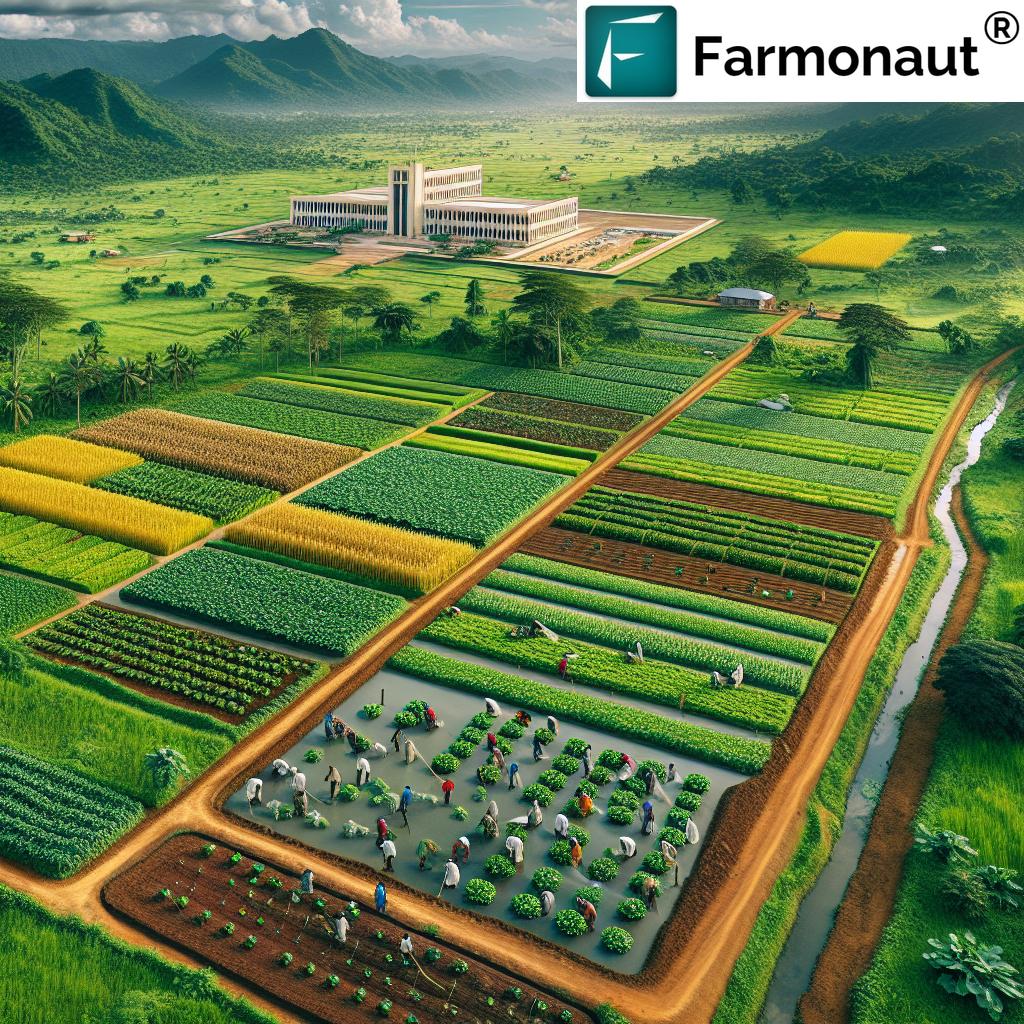Regenerative Coffee Farming Boosts Yields and Incomes in Kenya, Uganda
“Regenerative coffee farming in Kenya and Uganda can increase smallholder yields by up to 30% compared to conventional methods.”
Table of Contents
- Introduction: The Urgency of Regenerative Coffee Farming
- What is Regenerative Coffee Farming?
- Regenerative Agriculture Benefits for Coffee Production
- Country Insights: The Impact in Kenya and Uganda
- Sustainable Agriculture Practices in Coffee Farming
- Transitioning to Regenerative Agriculture: Challenges & Solutions
- Farmonaut: Enabling Sustainable Coffee Farming with Precision Technology
- Comparative Impact Table
- Realizing the Opportunity: Investing in the Future of Coffee
- Frequently Asked Questions (FAQ)
Introduction: The Urgency of Regenerative Coffee Farming
As the global demand for coffee intensifies, farmers across notorious coffee belts such as Kenya and Uganda are confronting new pressures—depleted soils, erratic weather, and volatile markets. In this context, the move toward regenerative coffee farming is not just a trend, but a crucial step for ensuring a prosperous, sustainable future for both smallholder communities and the planet.
Recent research from an international nonprofit underscores transformative results: adopting regenerative agriculture could increase smallholder farmer incomes by an average of 62%, boost yields, and reduce greenhouse gas emissions in agriculture by millions of tons of CO₂e annually. We find ourselves at a pivotal moment, where public and private investments in sustainability can deliver significant benefits to people and nature alike.
What is Regenerative Coffee Farming?
At its core, regenerative coffee farming involves practices that restore and enhance natural ecosystems, rather than merely sustaining current conditions. Unlike conventional production systems—which often rely heavily on chemical inputs and monocultures—regenerative strategies such as agroforestry coffee practices, cover cropping, and organic waste fertilization in coffee farms work synergistically to:
- Improve soil health and fertility
- Boost crop yields sustainably
- Enhance biodiversity and ecosystem services
- Reduce greenhouse gas emissions in agriculture
- Increase farmer income and resilience
By transitioning to regenerative agriculture, we move beyond “doing no harm” and instead actively work to restore the landscapes on which coffee farms depend.
Regenerative Agriculture Benefits for Coffee Production
A detailed study covering nine of the world’s leading coffee-producing countries—including Kenya, Uganda, Brazil, Vietnam, Colombia, Honduras, Indonesia, Ethiopia, and Peru—shows that regenerative agriculture benefits are both extensive and measurable:
- Yields: Adopting regenerative coffee farming practices is projected to improve yields on smallholder farms by 30% on average, with even greater results in some regions.
- Incomes: The shift could increase smallholder farmer incomes by an average of 62%, with Kenyan farmers potentially seeing a 196% rise.
- Coffee Exports: The model predicts a 30% boost in global coffee exports, strengthening local economies and spurring additional growth in the sector.
- Emissions: Regenerative coffee farming could reduce greenhouse gas emissions in agriculture by 3.5 million tons of CO₂e annually across the nine featured countries.
- Soil Health & Biodiversity: Practices like agroforestry and organic amendment use promote richer soils, improve water retention, and encourage wildlife, fostering long-term sustainability.
These findings confirm what experts have observed for decades: regenerative approaches are essential not just for nature, but for farmers’ livelihoods and the future of the coffee industry.
“Sustainable practices in East African coffee farms have reduced greenhouse gas emissions by nearly 20% while boosting farmer incomes.”
Country Insights: The Impact in Kenya and Uganda
Nowhere are the opportunity and necessity for regenerative coffee farming more evident than in Kenya and Uganda:
Kenya: Smallholder Transformation
- Income Increase: The study indicates potential for a 196% increase in smallholder farmer incomes—a transformative shift that holds power to lift entire communities out of poverty by improving coffee yields sustainably.
- Improved Productivity: Adoption of agroforestry coffee practices and organic waste fertilization in coffee farms naturally increases farm productivity, making yields more resilient to climate variability.
Uganda: Leading Robusta Coffee Exports and Climate Action
- Export Growth: Uganda, a global Robusta leader, could see a 52% rise in Robusta coffee exports by implementing regenerative practices.
- Emission Reductions: Sustainable agriculture practices are linked to notable reductions in greenhouse gas emissions in agriculture—nearly 20% as documented in select East African farms.
Both countries, representative of the wider East African coffee landscape, are poised to benefit not only economically but environmentally from strategic, proven interventions.
Sustainable Agriculture Practices in Coffee Farming
For farmers and agribusinesses in Kenya, Uganda, and around the world, the path to improvement lies in adopting a suite of sustainable agriculture practices proven to generate economic, environmental, and social returns:
- Agroforestry Coffee Practices – Integrating trees with crops to protect soil, provide shade, and restore habitat for beneficial wildlife. This is correlated with increased biodiversity and more resilient microclimates on coffee farms.
- Organic Waste Fertilization in Coffee Farms – Using composted coffee pulp, animal manure, or other organic waste to fertilize crops, which reduces input costs, enhances soil structure, and cuts greenhouse gas emissions in agriculture by cycling nutrients instead of relying on synthetic fertilizers.
- Soil Conservation Techniques – Terracing, mulching, and cover cropping hold soil in place, prevent erosion, and maintain moisture critical to sustained yields.
- Water Management – Employing rainwater harvesting and efficient irrigation ensures coffee plants receive consistent hydration, especially in regions grappling with climate extremes.
- Integrated Pest Management (IPM) – Encourages biological controls and crop rotation rather than over-reliance on chemical sprays, benefitting both human health and the wider ecosystem.
The cumulative effect of these sustainable agriculture practices is restoring nature while strengthening local economies in coffee-growing regions.
To support such sustainable strategies, Farmonaut offers advanced large-scale farm management tools that leverage satellite-based crop health monitoring, resource tracking, and AI-driven decision support. These solutions empower coffee cooperatives and agribusinesses to plan, monitor, and optimize the implementation of regenerative agriculture at scale—reducing costs and improving yields.
Transitioning to Regenerative Agriculture: Challenges & Solutions
Although the benefits are clear, the journey toward widespread regenerative coffee farming adoption is not without challenges:
- Knowledge Gaps: Many growers require training in new practices—from agroforestry to compost management.
- Financial Barriers: Upfront investments in tools, seedlings, or infrastructure can deter smallholder farmers, despite long-term income gains.
- Market Access: Ensuring access to premium markets that reward sustainability is crucial for converting early investments into tangible economic returns.
- Tracking and Verification: Being able to prove sustainable production and emission reductions requires robust, transparent data systems.
Overcoming these obstacles will require collaborative action across public, private, and nonprofit sectors, supplemented by technology-driven systems that lower risk and increase transparency for farmers and stakeholders.
Farmonaut: Enabling Sustainable Coffee Farming with Precision Technology
To support coffee farmers on their journey, Farmonaut delivers advanced, affordable, and accessible technology designed to democratize precision agriculture, boost yields, and reduce environmental impacts. Our mission is to empower the global agricultural sector—especially smallholders in Kenya and Uganda—by providing actionable insights directly from satellite imagery, artificial intelligence, and blockchain systems.
Key Precision Agriculture Features from Farmonaut
-
Satellite-Based Crop Health Monitoring:
- Analyze vegetation health, growth, and stress with multispectral imaging (NDVI and others).
- Support optimal irrigation, fertilization, and pest management.
Learn how our carbon footprinting tool helps track and reduce emissions in agriculture.
-
AI-Based Jeevn Advisory System:
- Provides personalized, real-time recommendations for sustainable coffee farm management backed by best-in-class expertise.
-
Blockchain-Based Product Traceability:
-
Enables tamper-proof tracking of coffee beans, ensuring supply chain transparency and builds consumer trust for sustainable production.
Discover Farmonaut’s blockchain-based coffee traceability solutions for authentic, sustainable, and ethical supply chains.
-
Enables tamper-proof tracking of coffee beans, ensuring supply chain transparency and builds consumer trust for sustainable production.
-
Resource and Fleet Management:
- Optimizes logistics and reduces operational costs for farmer groups, cooperatives, and agribusinesses.
-
Explore precision fleet management tools for agricultural logistics optimization.
-
Access to Financing:
-
Farmonaut enables satellite-based verification for crop loans and insurance, improving farmers’ access to finance while reducing fraud.
See how Farmonaut’s crop loan and insurance verification supports smallholder resilience.
-
Farmonaut enables satellite-based verification for crop loans and insurance, improving farmers’ access to finance while reducing fraud.
-
App & API Accessibility: Our data-driven insights are accessible via our web and mobile apps for iOS and Android, or programmatically through the
Farmonaut API
and detailed developer documentation.
Thanks to these tools, growers across Kenya, Uganda, and beyond can increase farm productivity, conserve resources, and implementing regenerative agriculture at scale—all while contributing data to track reductions in emissions and improvements in yield.
For advanced insights on sustainable plantation management, our crop, plantation, and forest advisory solutions are designed to help you maximize long-term crop health and optimize resource allocation—essential for smart, scalable coffee farming.
Comparative Impact Table: Regenerative vs. Conventional Coffee Farming in Kenya & Uganda
| Practice Type | Estimated Increase in Yield (%) | Estimated Increase in Smallholder Income (%) | Estimated Reduction in Greenhouse Gas Emissions (%) | Additional Benefits |
|---|---|---|---|---|
| Regenerative Coffee Farming | +30% | +62% (up to +196% in Kenya) | -15 to -20% |
|
| Conventional Coffee Farming | Baseline (0%) | Baseline (0%) | Varies |
|
Realizing the Opportunity: Investing in the Future of Coffee
To fully seize the potential of regenerative agriculture in coffee production, a significant average investment is necessary. The latest data shows an estimated annual requirement of $560 million globally for seven years. These funds will drive:
- Technical training and capacity building for smallholder farmers
- Access to sustainable inputs and seedlings required for agroforestry
- Financial services and risk mitigation to enable adoption of new practices
- Robust monitoring and verification technologies for tracking yields and emission reductions
The return on investment is staggering: $2.6 billion in additional coffee exports and $2.1 billion in extra income generated for farmers per year if all projected changes are realized.
At Farmonaut, our contribution comes through cost-effective precision farming tools that provide real-time analytics, reduce manual errors, and help coffee farmers adopt sustainable practices with confidence—lowering the barriers to participation in this agricultural revolution.
🌱 Want to integrate real-time crop and weather data into your tools or research?
Access the Farmonaut API and get started with our Developer Documentation to explore the future of sustainable agriculture!
Frequently Asked Questions (FAQ)
-
What is regenerative coffee farming?
Regenerative coffee farming refers to agricultural practices that restore ecosystems, improve soil health, sequester carbon, and enhance both profitability and sustainability for coffee growers. Key techniques include agroforestry, organic waste fertilization, and integrated crop-livestock systems.
-
How does regenerative farming increase smallholder farmer incomes?
By adopting practices that boost coffee yields, reduce input costs, and open access to premium markets, smallholders can see incomes rise dramatically—up to 196% in Kenya, according to the latest research.
-
How significant is the reduction in greenhouse gas emissions from regenerative agriculture?
Regenerative coffee farming can reduce agricultural greenhouse gas emissions by up to 3.5 million tons of CO₂e annually across major producing countries. This primarily results from improved soil carbon sequestration and reduced reliance on synthetic fertilizers.
-
Which countries are leading in regenerative coffee farming?
The latest data focuses on nine countries—Kenya, Uganda, Brazil, Vietnam, Colombia, Honduras, Indonesia, Ethiopia, and Peru—covering over 70% of global coffee production. Kenya and Uganda are rapidly emerging as leaders in East Africa.
-
What practical steps are needed to transition to regenerative coffee production?
Farmers should seek technical assistance, invest in knowledge transfer for agroforestry, embrace organic fertilization, and use precision tracking tools such as those from Farmonaut to monitor progress and results.
-
How does Farmonaut support coffee farmers’ sustainability journey?
Farmonaut provides satellite-based crop monitoring, AI-driven advisories, blockchain-based traceability, fleet management, carbon footprinting, and app/API access. These services help farmers optimize inputs, lower emissions, and increase yields—making regenerative agriculture both feasible and profitable.
-
How can I get started with Farmonaut?
Simply download the Farmonaut app for web, Android, or iOS, or explore our API to empower your sustainable coffee farming journey.
Conclusion: Building Sustainable Communities Through Regenerative Coffee Farming
As we have seen, the transition to regenerative coffee farming holds enormous promise—not only for increasing smallholder farmer incomes and enhancing yields, but for restoring our planet and securing the future of the global coffee industry. By harnessing innovative technology like Farmonaut’s precision agriculture platform, and by embracing sustainable agriculture practices at scale, together we can empower farmers in Kenya, Uganda, and beyond to thrive—now and for generations to come.
Let’s strengthen local economies, support resilient food systems, and play our part in reducing greenhouse gas emissions in agriculture, one coffee farm at a time.
Ready to embark on your sustainable farming journey? Download Farmonaut today and cultivate a greener future!


